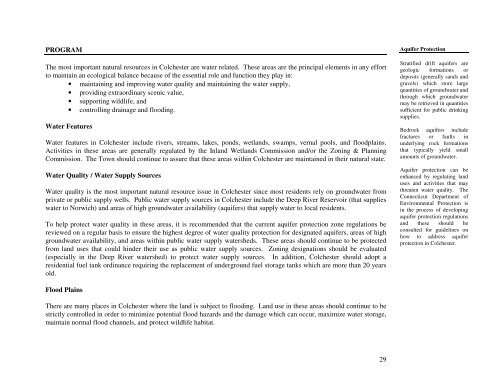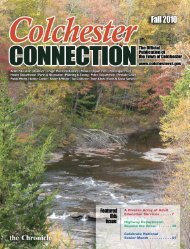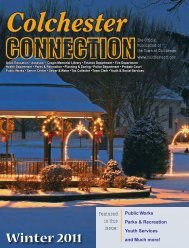2 - Town of Colchester
2 - Town of Colchester
2 - Town of Colchester
- No tags were found...
Create successful ePaper yourself
Turn your PDF publications into a flip-book with our unique Google optimized e-Paper software.
PROGRAM<br />
The most important natural resources in <strong>Colchester</strong> are water related. These areas are the principal elements in any effort<br />
to maintain an ecological balance because <strong>of</strong> the essential role and function they play in:<br />
• maintaining and improving water quality and maintaining the water supply,<br />
• providing extraordinary scenic value,<br />
• supporting wildlife, and<br />
• controlling drainage and flooding.<br />
Water Features<br />
Water features in <strong>Colchester</strong> include rivers, streams, lakes, ponds, wetlands, swamps, vernal pools, and floodplains.<br />
Activities in these areas are generally regulated by the Inland Wetlands Commission and/or the Zoning & Planning<br />
Commission. The <strong>Town</strong> should continue to assure that these areas within <strong>Colchester</strong> are maintained in their natural state.<br />
Water Quality / Water Supply Sources<br />
Water quality is the most important natural resource issue in <strong>Colchester</strong> since most residents rely on groundwater from<br />
private or public supply wells. Public water supply sources in <strong>Colchester</strong> include the Deep River Reservoir (that supplies<br />
water to Norwich) and areas <strong>of</strong> high groundwater availability (aquifers) that supply water to local residents.<br />
To help protect water quality in these areas, it is recommended that the current aquifer protection zone regulations be<br />
reviewed on a regular basis to ensure the highest degree <strong>of</strong> water quality protection for designated aquifers, areas <strong>of</strong> high<br />
groundwater availability, and areas within public water supply watersheds. These areas should continue to be protected<br />
from land uses that could hinder their use as public water supply sources. Zoning designations should be evaluated<br />
(especially in the Deep River watershed) to protect water supply sources. In addition, <strong>Colchester</strong> should adopt a<br />
residential fuel tank ordinance requiring the replacement <strong>of</strong> underground fuel storage tanks which are more than 20 years<br />
old.<br />
Aquifer Protection<br />
Stratified drift aquifers are<br />
geologic formations or<br />
deposits (generally sands and<br />
gravels) which store large<br />
quantities <strong>of</strong> groundwater and<br />
through which groundwater<br />
may be retrieved in quantities<br />
sufficient for public drinking<br />
supplies.<br />
Bedrock aquifers include<br />
fractures or faults in<br />
underlying rock formations<br />
that typically yield small<br />
amounts <strong>of</strong> groundwater.<br />
Aquifer protection can be<br />
enhanced by regulating land<br />
uses and activities that may<br />
threaten water quality. The<br />
Connecticut Department <strong>of</strong><br />
Environmental Protection is<br />
in the process <strong>of</strong> developing<br />
aquifer protection regulations<br />
and these should be<br />
consulted for guidelines on<br />
how to address aquifer<br />
protection in <strong>Colchester</strong>.<br />
Flood Plains<br />
There are many places in <strong>Colchester</strong> where the land is subject to flooding. Land use in these areas should continue to be<br />
strictly controlled in order to minimize potential flood hazards and the damage which can occur, maximize water storage,<br />
maintain normal flood channels, and protect wildlife habitat.<br />
29







